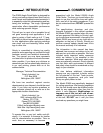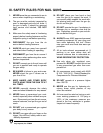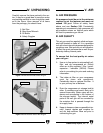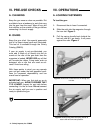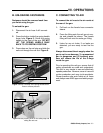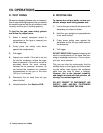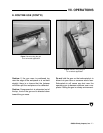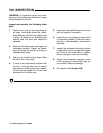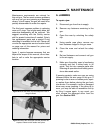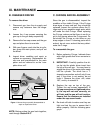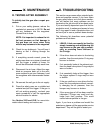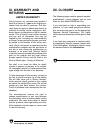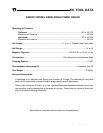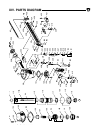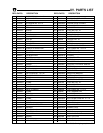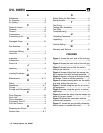
G3690 Grizzly Imports, Inc. - 11 -
IX. MAINTENANCE X. TROUBLESHOOTING
D. TESTING AFTER ASSEMBLY
To initially test the gun after a repair pro-
cedure:
1. Put on your safety glasses, reduce the
regulated air pressure to 30 PSI. Do not
put any fasteners into the magazine.
Connect the air hose.
NOTE: It is important to reduce the ini-
tial test pressure so that damage to
the gun does not occur when firing
without any fasteners in the magazine.
2. Check for any leaking air. You will hear it
hissing or feel it rushing through the
spaces.
3. If everything sounds normal, press the
safety nose down on a piece of wood and
pull the trigger a couple of times. Air
should be exhausted normally each time.
4. Disconnect the air hose. Adjust the regu-
lated air pressure back up to the mini-
mum required to set your fasteners. Load
the magazine with recommended fasten-
ers.
5. Re-connect the nail gun to the air supply.
6. Press the safety nose on a suitable test
material and pull the trigger. If the gun is
still not working properly, re-check your
repair procedure or call the appropriate
service location for advice.
See Section VII.D and VII.E. for more infor-
mation about testing and routine use.
This section covers some other potential prob-
lems and possible causes. If you have taken
the gun apart before, as in the above section,
you will realize that most problems can be
repaired on the job site with a few basic parts.
If you are heavily dependent upon this tool for
production work, it makes good sense to have
an O-ring repair kit and a complete driver unit
on hand just in case a problem does develop.
The following list describes some potential
problems and solutions.
1. LEAKS: A leak can usually be fixed by
simply loosening and retightening the
cap screws on the gun cap symmetri-
cally or providing more lubricant to
the O-rings.
2. If the driver does not return to its starting
position, then the main piston O-ring may
be worn or broken.
3. If air constantly leaks at the exhaust port,
then the head valve piston O-ring may be
worn or broken.
4. If air constantly leaks at the trigger, then
the trigger system O-rings may be worn
or broken.
5. If the gun misfires or over-drives the fas-
tener into the workpiece without manual-
ly changing the air pressure, then the
bumper may be worn or broken.
6. If the wrong type of oil has been used for
lubrication, O-rings may swell and dis-
lodge from their grooves. This could
cause leaks anywhere in the gun.
Again, if you have a problem and would like
assistance, please call the appropriate service
department. They will be glad to assist you.



